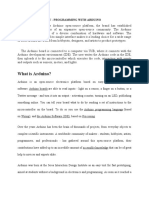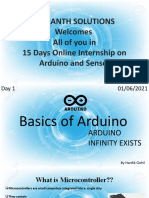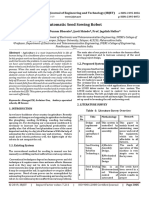France PDF
France PDF
Uploaded by
hresyh esysyhsCopyright:
Available Formats
France PDF
France PDF
Uploaded by
hresyh esysyhsOriginal Title
Copyright
Available Formats
Share this document
Did you find this document useful?
Is this content inappropriate?
Copyright:
Available Formats
France PDF
France PDF
Uploaded by
hresyh esysyhsCopyright:
Available Formats
What is Arduino?
Arduino is an open-source electronics platform based on easy-to-use hardware
and software. Arduino boards are able to read inputs - light on a sensor, a finger
on a button, or a Twitter message - and turn it into an output - activating a motor,
turning on an LED, publishing something online. You can tell your board what to
do by sending a set of instructions to the microcontroller on the board. To do so
you use the Arduino programming language (based on Wiring), and the Arduino
Software (IDE), based on Processing.
Why Arduino?
Thanks to its simple and accessible user experience, Arduino has been used in
thousands of different projects and applications. The Arduino software is easy-
to-use for beginners, yet flexible enough for advanced users. It runs on Mac,
Windows, and Linux. Teachers and students use it to build low cost scientific
instruments, to prove chemistry and physics principles, or to get started with
programming and robotics. Designers and architects build interactive
prototypes, musicians and artists use it for installations and to experiment with
new musical instruments. Makers, of course, use it to build many of the projects
exhibited at the Maker Faire, for example. Arduino is a key tool to learn new
things. Anyone - children, hobbyists, artists, programmers - can start tinkering
just following the step by step instructions of a kit, or sharing ideas online with
other members of the Arduino community.
• Inexpensive - Arduino boards are relatively inexpensive compared to other
microcontroller platforms. The least expensive version of the Arduino module
can be assembled by hand, and even the pre-assembled Arduino modules cost
less than $50
• Cross-platform - The Arduino Software (IDE) runs on Windows, Macintosh OSX,
and Linux operating systems. Most microcontroller systems are limited to
Windows.
• Simple, clear programming environment - The Arduino Software (IDE) is
easy-to-use for beginners, yet flexible enough for advanced users to take
advantage of as well. For teachers, it's conveniently based on the Processing
programming environment, so students learning to program in that environment
will be familiar with how the Arduino IDE works.
• Open source and extensible software - The Arduino software is published as
open source tools, available for extension by experienced programmers. The
language can be expanded through C++ libraries, and people wanting to
understand the technical details can make the leap from Arduino to the AVR C
programming language on which it's based. Similarly, you can add AVR-C code
directly into your Arduino programs if you want to.
• Open source and extensible hardware - The plans of the Arduino boards are
published under a Creative Commons license, so experienced circuit designers
can make their own version of the module, extending it and improving it. Even
relatively inexperienced users can build the breadboard version of the module in
order to understand how it works and save money.
The Arduino IDE
The Arduino IDE (Integrated Development Environment) is used to write the computer code and
upload this code to the physical board. The Arduino IDE is very simple and this simplicity is
probably one of the main reason Arduino became so popular. We can certainly state that being
compatible with the Arduino IDE is now one of the main requirements for a new
microcontroller board. Over the years, many useful features have been added to the Arduino
IDE and you can now managed third-party libraries and boards from the IDE, and still keep the
simplicity of programming the board. The main window of the Arduino IDE is shown below, with
the simple simple Blink example.
Description:
The 4 Channel Relay Module is a convenient board which can be used to control high
voltage, high current load such as motor, solenoid valves, lamps and AC load. It is
designed to interface with microcontroller such as Arduino, PIC and etc. The relays
terminal (COM, NO and NC) is being brought out with screw terminal. It also comes
with a LED to indicate the status of relay .
Specification:
• Digital output controllabl e
• Compatible with any 5V microcontroller such as Arduino .
• Rated through-current: 10A (NO) 5A (NC )
• Control signal: TTL level
• Max. switching voltage 250VAC/30VD C
• Max. switching current 10 A
• Size: 76mm x 56mm x 17m m
You might also like
- Arduino: The ultimate guide to Arduino, including projects, programming tips & tricks, and much more!From EverandArduino: The ultimate guide to Arduino, including projects, programming tips & tricks, and much more!No ratings yet
- Practicas Labview ArduinoDocument3 pagesPracticas Labview ArduinoMihai Bogdan0% (1)
- Getting Started With Matlab Simulink and Arduino PDFDocument91 pagesGetting Started With Matlab Simulink and Arduino PDFfuji1390% (20)
- Learn LCD Arduino-V1-B PDFDocument51 pagesLearn LCD Arduino-V1-B PDFbolajiNo ratings yet
- IV - Programming With ArduinoDocument22 pagesIV - Programming With ArduinoJovens CabacheteNo ratings yet
- 4148 - File - Lesson 1 What Is ArduinoDocument2 pages4148 - File - Lesson 1 What Is Arduinogracilla5426No ratings yet
- What Is Arduino?Document18 pagesWhat Is Arduino?Hamza AliNo ratings yet
- What Is Arduino?Document4 pagesWhat Is Arduino?Zakaria MourtadiNo ratings yet
- 1.arduino UnoDocument3 pages1.arduino Unodarshandarshana711No ratings yet
- IOT Arduino BoardDocument20 pagesIOT Arduino BoardPrabir dasNo ratings yet
- What Is Arduino?Document3 pagesWhat Is Arduino?KutluNo ratings yet
- Arduino TutorialDocument280 pagesArduino TutorialRohitNo ratings yet
- AN Introductio Ntothe Arduino: Name: R.R.R.B.P.W.S.S.Palihawadan A Reg. No: 413338900Document13 pagesAN Introductio Ntothe Arduino: Name: R.R.R.B.P.W.S.S.Palihawadan A Reg. No: 413338900geetha kanthiNo ratings yet
- Unit IIarduino 1Document27 pagesUnit IIarduino 1Alroy AlmeidaNo ratings yet
- Arduino and Elective IntroDocument2 pagesArduino and Elective IntroBrittaney BatoNo ratings yet
- Arduino: Arduino Is An Open-Source Single-Board Microcontroller, Descendant of The Open-Source WiringDocument2 pagesArduino: Arduino Is An Open-Source Single-Board Microcontroller, Descendant of The Open-Source WiringratheeshbrNo ratings yet
- Digital Dice BROCHREDocument4 pagesDigital Dice BROCHREK JoshiNo ratings yet
- Arduinocompiler: Embedded: Designing & Programming Using ArduinoDocument6 pagesArduinocompiler: Embedded: Designing & Programming Using ArduinoPrince TiwariNo ratings yet
- Arduino PresentationDocument15 pagesArduino PresentationhoriciusNo ratings yet
- Internet of Things & Its Applications: O-Level ProjectDocument10 pagesInternet of Things & Its Applications: O-Level ProjectVikas MishraNo ratings yet
- ARDUINO UNO ReportDocument116 pagesARDUINO UNO ReportRailu BandiNo ratings yet
- Arduino OdtDocument4 pagesArduino OdtsweetsureshNo ratings yet
- Arduino Is An Open-Source Prototyping Platform Based On Easy-To-Use Hardware and Software. ArduinoDocument3 pagesArduino Is An Open-Source Prototyping Platform Based On Easy-To-Use Hardware and Software. Arduinovemala vandanaNo ratings yet
- Arduino CCDocument14 pagesArduino CCRachana SrinivasNo ratings yet
- Arduino: A Beginner's Guide to Arduino ProgrammingFrom EverandArduino: A Beginner's Guide to Arduino ProgrammingRating: 3 out of 5 stars3/5 (1)
- UNDERSTANDING ARDUINO A Beginners Guide With Realtime Insights and Tricks To Learn Arduino ProgrammingDocument39 pagesUNDERSTANDING ARDUINO A Beginners Guide With Realtime Insights and Tricks To Learn Arduino ProgrammingLuis Baldassari100% (1)
- InternshipDocument10 pagesInternshipShreyaa DesaiNo ratings yet
- Computer 9 Module 11Document6 pagesComputer 9 Module 11Lester LaurenteNo ratings yet
- ArduinoDocument9 pagesArduinoSinthiya SinthiNo ratings yet
- Arduino Projects EASY PROJECTS FOR BEGINNERS Your Guide To Building Simple Arduino ProjectsDocument77 pagesArduino Projects EASY PROJECTS FOR BEGINNERS Your Guide To Building Simple Arduino ProjectsGuzmán Hernández Jesús Alfonso100% (1)
- Hands Notes - Basics of ArduinoDocument30 pagesHands Notes - Basics of Arduinoblackspidey1439No ratings yet
- What Is An ArduinoTypes, Projects and ApplicationsDocument16 pagesWhat Is An ArduinoTypes, Projects and ApplicationsjackNo ratings yet
- The Arduino MicrocontrollerDocument16 pagesThe Arduino Microcontrollerطه عمر طهNo ratings yet
- WorskShop Lab 5Document22 pagesWorskShop Lab 5manavlund5No ratings yet
- EMBEDDED SYSTEM LAB TRAINER Instruction ManualDocument27 pagesEMBEDDED SYSTEM LAB TRAINER Instruction ManualyogeshNo ratings yet
- Arduino BasicsDocument6 pagesArduino BasicsMgasa LucasNo ratings yet
- Arduino For Beginners: How to get the most of out of your Arduino, including Arduino basics, Arduino tips and tricks, Arduino projects and more!From EverandArduino For Beginners: How to get the most of out of your Arduino, including Arduino basics, Arduino tips and tricks, Arduino projects and more!No ratings yet
- IOT Unit02 L14 Extra ArduinoDocument4 pagesIOT Unit02 L14 Extra ArduinoSanjay Kumar MahatoNo ratings yet
- Arduino Home-Automation PDFDocument20 pagesArduino Home-Automation PDFRifqi Dwi PrabowoNo ratings yet
- Additional Specifications: - Rotational Range: 180° - Pulse Cycle: Ca. 20 Ms - Pulse Width: 500-2400 SDocument1 pageAdditional Specifications: - Rotational Range: 180° - Pulse Cycle: Ca. 20 Ms - Pulse Width: 500-2400 SR S PappuNo ratings yet
- Lesson 1:: Instructables ClassesDocument15 pagesLesson 1:: Instructables ClassesLandy AdianetNo ratings yet
- What Are The Different Types of Arduino BoardsDocument7 pagesWhat Are The Different Types of Arduino Boardsعبد الله علي عمر بن قديم100% (1)
- Working Principle of Arduino and Using It As A Tool For Study and ResearchDocument9 pagesWorking Principle of Arduino and Using It As A Tool For Study and ResearchijcacsNo ratings yet
- Lab 06Document2 pagesLab 06RohitNo ratings yet
- Guided By-Dr. Shilpa Kabra: What Is Arduino?Document22 pagesGuided By-Dr. Shilpa Kabra: What Is Arduino?RAM BrothersNo ratings yet
- CreateSpace ArduinoDocument57 pagesCreateSpace ArduinoMichel Müller100% (1)
- Arduino Expt1Document4 pagesArduino Expt1Shang Divina EbradaNo ratings yet
- Nilkanth Solutions Welcomes All of You in 15 Days Online Internship On Arduino and SensorsDocument13 pagesNilkanth Solutions Welcomes All of You in 15 Days Online Internship On Arduino and SensorsGohil HardikNo ratings yet
- Guia Arduino para Iniciantes:: Tudo Que Você Precisa Saber para ComeçarDocument39 pagesGuia Arduino para Iniciantes:: Tudo Que Você Precisa Saber para Começarleoscribd13No ratings yet
- Understanding The Arduino Integrated Development EnvironmentDocument6 pagesUnderstanding The Arduino Integrated Development EnvironmentjackNo ratings yet
- Experiment No. 01: AIM TheoryDocument6 pagesExperiment No. 01: AIM TheoryHarshada BansodeNo ratings yet
- Arduino Training Course Outline With LectureDocument19 pagesArduino Training Course Outline With Lecturejace jaceNo ratings yet
- IntroductionToTheArduinoMicrocontroller PDFDocument3 pagesIntroductionToTheArduinoMicrocontroller PDFNikhilesh ThatipamulaNo ratings yet
- F C&P Lab 13Document3 pagesF C&P Lab 13siddiqueeluqmanNo ratings yet
- ArduinoDocument4 pagesArduinoAko Omer MahmoodNo ratings yet
- 05 - Arduino ImplementationDocument9 pages05 - Arduino ImplementationmanthanstdNo ratings yet
- Arduino - Wikipedia, The Free Encyclopedia PDFDocument6 pagesArduino - Wikipedia, The Free Encyclopedia PDFbeta2009No ratings yet
- Arduino Integrated Development Environment (IDE) : MembersDocument16 pagesArduino Integrated Development Environment (IDE) : MembersPoornima GSNo ratings yet
- Arduino & ProteusisisDocument15 pagesArduino & Proteusisisspider kingNo ratings yet
- Lab Report#2: Introduction To Atmega 328p/ardunio Ide Uno, Arduino Ide and ProteousDocument4 pagesLab Report#2: Introduction To Atmega 328p/ardunio Ide Uno, Arduino Ide and Proteoushamza shahbazNo ratings yet
- Internet of Things Technology 15CS81Document44 pagesInternet of Things Technology 15CS81ArunNo ratings yet
- The Arduino Handbook - Learn Microcontrollers For Embedded SystemsDocument132 pagesThe Arduino Handbook - Learn Microcontrollers For Embedded Systemstalha.k.rajpootNo ratings yet
- IOT Arduino IntroDocument2 pagesIOT Arduino IntroAmin ShaikNo ratings yet
- Mblock5 Getting StartedDocument7 pagesMblock5 Getting StartedPriitNo ratings yet
- Arduino Voting MachineDocument6 pagesArduino Voting MachineBo Tauk HteinNo ratings yet
- O Level Syllabus: Paper (1) IT Tools & Basics of NetworksDocument8 pagesO Level Syllabus: Paper (1) IT Tools & Basics of NetworksShishir Kant SinghNo ratings yet
- Automatic Water Tank Filling SystemDocument5 pagesAutomatic Water Tank Filling SystemMuhammad AliNo ratings yet
- Placa 32u4s ArduinoDocument24 pagesPlaca 32u4s ArduinoDiego Sales100% (1)
- Programming Arduino With LabVIEW - Build Interactive and Fun Learning Projects With Arduino Using LabVIEWDocument102 pagesProgramming Arduino With LabVIEW - Build Interactive and Fun Learning Projects With Arduino Using LabVIEWsamsoum1No ratings yet
- Final Thesis Report: Hawassa UniversityDocument57 pagesFinal Thesis Report: Hawassa UniversityEsiyak MengeshaNo ratings yet
- Density Based Traffic Light Control System Report (Rough)Document19 pagesDensity Based Traffic Light Control System Report (Rough)Kunal AdhikariNo ratings yet
- Automatic Seed Sowing Robot: International Research Journal of Engineering and Technology (IRJET)Document3 pagesAutomatic Seed Sowing Robot: International Research Journal of Engineering and Technology (IRJET)Teshome GetachewNo ratings yet
- Pantalla Arduino MegaNHD-4.3RTP-SHIELD User GuideDocument16 pagesPantalla Arduino MegaNHD-4.3RTP-SHIELD User GuideKevin RojasNo ratings yet
- Wiring 7 Segement Displays To Arduino - The SimDocument1 pageWiring 7 Segement Displays To Arduino - The Simbondomargalitadze margalitadzeNo ratings yet
- FutureDocument37 pagesFutureBT20EEE052 KhushalNo ratings yet
- Whole PDF FreeDocument85 pagesWhole PDF Freeagustizon02No ratings yet
- 4Ch IR Sensor PDFDocument7 pages4Ch IR Sensor PDFDuzzys100% (1)
- Fiot-Ii UnitDocument35 pagesFiot-Ii UnitHARSHINI RAVVANo ratings yet
- How Do I Load The Labview Interface For Arduino Firmware Onto My Arduino Uno - National InstrumentsDocument6 pagesHow Do I Load The Labview Interface For Arduino Firmware Onto My Arduino Uno - National Instrumentsnoor aliNo ratings yet
- Chapter 2Document15 pagesChapter 2Shelanie OlivarNo ratings yet
- Automation of Object Sorting System Usin PDFDocument5 pagesAutomation of Object Sorting System Usin PDFVũ Mạnh CườngNo ratings yet
- Drawing RobotDocument9 pagesDrawing Robotmarius_danila8736100% (1)
- Smart GloveDocument8 pagesSmart GloveRakshit VigNo ratings yet
- DC Motor Speed Control by Android: A Synopsis On Project Submitted byDocument13 pagesDC Motor Speed Control by Android: A Synopsis On Project Submitted byshailesh kumarNo ratings yet
- Dec50122-Introduction To Proteus SimulationDocument15 pagesDec50122-Introduction To Proteus Simulationnur hazirahNo ratings yet
- Control Lab ReportDocument18 pagesControl Lab ReportImran FarhanNo ratings yet
- Fire Fighting RobotDocument49 pagesFire Fighting Robotharsha papisettiNo ratings yet
- Project Report: Bore-Well Rescue Using Robotic ArmDocument19 pagesProject Report: Bore-Well Rescue Using Robotic ArmEdson Steve D'SouzaNo ratings yet
- Internet of Things-1Document6 pagesInternet of Things-1FLOWERNo ratings yet
- Arduino Experimenters GuideDocument32 pagesArduino Experimenters Guiderudyzarzoff100% (2)

























































































